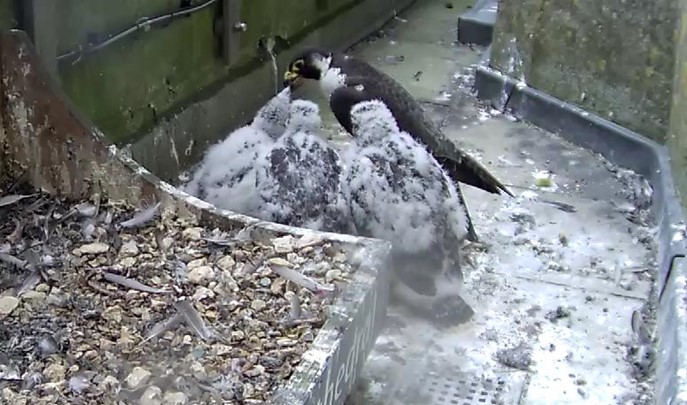Peregrine Blog 2023 – No 3

By Granville Pictor, 22 May 2023
Don’t they grow fast? On 1 May when I penned my last blog, the three chicks were just tiny bundles of white down. Today as I type they are almost four weeks old with feather quills beginning to replace their white down. With the down on their heads rapidly being shed, they are beginning to acquire the rather distinctive moustachioed look of their parents. They have in the last two days become a great deal more mobile and all three have now left the nest box and are exploring the walkway around the box. In past years it has often been just one brave chick that has left the box quite early leaving the other two in situ as it were. In this situation the adult birds have returned to the box with prey and mostly fed just the chicks in the box with the one outside looking on and calling rather plaintively. In past years viewers of the nest cam have worried that the chick outside of the box might not be able to get back in as it does not seem to have the strength or ‘spring’ to be able to jump back into the box. To assist any ‘early leavers’, a few years ago we positioned two bricks beside the box to give any chick a step up as it were and this has enabled such chicks to return to the safety of the box and be reunited with its siblings. These two bricks are still in situ and can be seen on the balcony nest cam. With all three having left the box it may well be that none will return to the box; we shall see. One reason they might return to the box is if we have any particularly heavy rain and the walkway gets very wet. That said, when the chicks were recently ringed, the opportunity was taken at the same time to clean off the metal grills over both drain covers of feather debris and general detritus so that should alleviate any chance of flooding. With the weather set fair for the next week or so, hopefully we should have no problems in that direction.
Speaking of rain, when we had a particularly heavy storm a week or so ago, viewers of the nest cam may have noted some behaviour which is not often observed. With the rain pouring down, our very dutiful female covered the chicks from the worst of the weather to the best of her ability. She was clearly hungry at the time and the male arrived and fed her small pieces of food, bill to bill in the same way as an adult feeds small chicks; they are clearly a dedicated couple. This is not always the case, and I gather from other Peregrine contacts that I have, that in recent weeks some adult males in particular seem to have less of a bond to their chicks than might be expected. There does seem to be quite a high turnover of adult birds at some urban sites, perhaps the pressure of young adults seeking territories and seeking to oust established birds is responsible. Either way, some of these inexperienced birds are clearly not up to the task in hand and seemingly not taking their parental duties entirely seriously. I heard only this morning of one site where there is a new male but he seems to have shown very little interest in the eggs or newly hatched chicks. To quote my contact, ‘he’s like an excitable kid, and a bit clueless. All he really seems to be interested in is displaying/courtship’. As I say, our pair seem to be model parents and long may it continue.
I mentioned in my previous blog that it seemed unlikely that the fourth egg would hatch. This proved to be the case, and in due course the unhatched egg was moved to one side and rapidly became soiled. It was planned at the same time as when the chicks were ringed to collect the unhatched egg. Alas the best plans of mice and men! On 9 May it became apparent that the egg was no longer present. A review of the nest cam footage revealed that the adult female arrived at the nest box and presumably inadvertently landed on the egg and it broke. From what I could see, the content of the egg was just yolk and albumen and it did not contain an unhatched chick. The egg was thus likely to be infertile which is not an uncommon occurrence with raptor eggs. Had the egg still been intact when the chicks were ringed, we would have collected the egg and sent it off to the Predatory Bird Monitoring Scheme (PBMS). To quote their website, ‘The aim of the PBMS is to detect and quantify current and emerging chemical threats to the environment. It achieves this by monitoring the concentrations of contaminants of concern in bird carcasses and eggs. This provides information on the extent of risk to vertebrate wildlife (and potentially Man) and how this varies temporally and spatially. Such variation can result from market-led or regulatory changes in chemical use. It may also be associated with larger-scale phenomena, such as global environmental change, which can alter the environmental fate and behaviour of chemicals.’ In practice, the PBMS receives about 300-400 bird carcasses a year, mostly from birds killed accidentally from flying into obstacles or from starvation and disease. It also receives unhatched eggs which when analysed can reveal concentrations of things like pesticide residues etc……….alas our egg did not present itself for analysis!
As I mentioned previously, the chicks have been ringed. This was done on 17 May 2023 with the usual media coverage including a large article and photographs of the birds being ringed in The Guardian newspaper; nationwide fame for our birds. I imagine regular viewers of the nest cam may have guessed from their relative sizes that we had two females and a male this year, and indeed this proved to be the case. As in past years, each chick was given a British Trust for Ornithology (BTO) small metal ring and a larger orange coloured Darvic ring on which there are three large black upper case letters. These Darvic rings and their letters are sufficiently large as to enable them to be read through a telescope or nest box webcam; it is via these rings that we have been able to track the movements of several of our past chicks. Not only are the chicks ringed, but as in past years they are also given names. This year the names were Coronation themed and the adopted names were given, as usual, by public vote. The details of the three chicks are as follows:
Rose; female, Darvic ring VHR, weight 930g.
Lily; female, Darvic ring VRR, weight 840g.
Rex; male, Darvic ring VDR, weight 655g.
If all goes well, our three chicks should fledge in early June. As in previous years, the local Salisbury RSPB group will be organising their Peregrine themed ‘Date with Nature’ on the west lawn of the cathedral. This starts on 6 June and carries on for most of that month. There will be the usual two telescopes set up so that visitors can have a good view of the adults and the chicks, and there will be RSPB volunteers on hand manning the telescopes and to answer the many questions which are always posed. So why not come down and join us; I promise you will not be disappointed.




